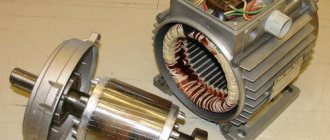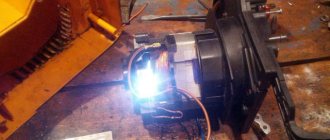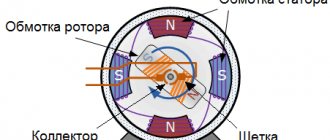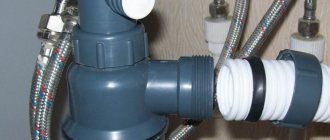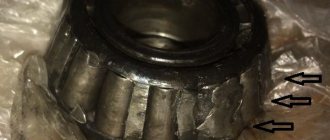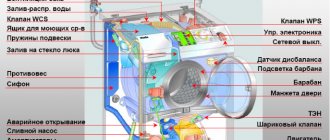The washing machine sparks
It happens that a flickering light appears at the bottom of the washing machine. This indicates that the machine began to spark. Naturally, such a problem will quickly attract the attention of the owner of the machine and he will turn it off in order to study the causes of the breakdown.
Why does the washing machine spark?
How does such a problem arise?
The washing machine sparks during operation, and sparking may appear due to some signs:
· Accompanied by an intermittent sound.
· Sparks can be seen through the glass surface of the unit, which is located inside the tank.
What are the causes of failure?
The washing machine sparks during operation and the main reasons for the appearance of sparks are:
· Failure of electric motor brushes.
· Possible damage to the lamellas of the motor commutator.
· A short circuit has occurred in the heating element.
· Failure of the electronic module.
You need to know that as soon as such problems appear, you should immediately disconnect the machine from the power supply.
The heating element of the washing machine has failed
Another problem why a washing machine sparks is a failed heating element. It is responsible for heating the water in the washing machine. Sometimes the sparking of heating elements can be observed even through glass.
If sparks are observed, then it is necessary to very quickly disconnect the washing machine from the network, without touching the case, since current can also flow through it.
If you have a multimeter at home, you can use it to check the performance of the heating element. You can find out from our article - Repair of heating elements. Troubleshooting.
Instead, you can use any other pointer devices. If the heating element turns out to be a “fallen warrior,” then it is urgently necessary to replace it. Before this time, turning on the washing machine is strictly prohibited. It is worth noting that in this case, only a complete replacement of the heating element will help, since this element cannot be repaired.
And if you checked it and it’s ok, then you should probably descale it. We also have an article - removing scale from the electrode of a heating element.
Washing machine motor sparks
Reasons
: Perhaps the washing machine motor is sparking, and here you need to look at the brushes. Sparking of the motor brushes can occur when there is loose contact with the commutator inside the machine.
Washing machine brushes often spark, and this happens when the machine has been in use for a long time. Here it is possible that the brushes have worn down to such a state that contact still occurs, but it is no longer strong.
In this state, the unit can operate for some more time, but when the spin mode is turned on, the owner will notice that a spark has appeared at the bottom.
In order to repair such a breakdown, you need to inspect the engine and, if necessary, replace the brushes. After such parts are replaced, sparking may persist. Here the question immediately arises: the washing machine is sparking, what to do and what to do?
This happens because the installed brushes have not yet gotten used to it. When replacing brushes, the owner must remember that maximum load modes should not be turned on (10 washes). You cannot load a lot of laundry into the unit. This is all done so that the brushes begin to work and there is good contact.
The heating element sparks in the washing machine
Now we know why a washing machine sparks - if the sparks are strong and appear only when the electric motor is running, then the problem is in the motor. But sometimes the reason lies in something completely different. For example, a worn heating element can easily spark in a washing machine - in some cases, sparks are visible even through the glass. If this really happens, you should immediately turn off the power to the washing machine without touching its body.
Next, we gain access to the heating element and check it with a multimeter (in diode testing mode, with sound indication), touching it with probes to the current-carrying contacts and to the housing - if the heating element “breaks through” onto the housing, the multimeter will beep and change readings. Instead of a multimeter, you can use dial gauges (in ohmmeter mode) - here it is easier to notice the slightest fluctuations in resistance. If the heating element fails, it must be unconditionally replaced - the heating elements are not repaired.
Sometimes the junction of the heating element with the wires can spark - in this case, you just need to clean the oxidized contacts.
Washing machine repair cost
| Visit of the master | 0 rub. |
| Samsung washing machine repair | from 1850 rub. |
| LG washing machine repair | from 1750 rub. |
| Bosch washing machine repair | from 1750 rub. |
| Indesit washing machine repair | from 1550 rub. |
| Ariston washing machine repair | from 1450 rub. |
| Candy washing machine repair | from 1550 rub. |
| Zanussi washing machine repair | from 1850 rub. |
| Electrolux washing machine repair | from 1800 rub. |
| Miele washing machine repair | from 3000 rub. |
| Whirlpool washing machine repair | from 2200 rub. |
| BEKO washing machine repair | from 1550 rub. |
| Siemens washing machine repair | from 2450 rub. |
| Ardo washing machine repair | from 1800 rub. |
| AEG washing machine repair | from 1850 rub. |
| Brandt washing machine repair | from 1700 rub. |
| Washing machine repair Atlant | from 1500 rub. |
| Gorenje washing machine repair | from 1850 rub. |
| Hotpoint Ariston washing machine repair | from 2000 rub. |
| Other brands of washing machines | from 1500 rub. |
If you decide to call our company, then you need to provide some information about the operation of the machine:
The washing machine sparks when washing. What to do? Causes
If the washing machine sparks, this may indicate a malfunction, or an imminent serious breakdown. It is impossible to ignore sparks, because using a washing machine that sparks is fraught with electric shock, equipment failure and other negative consequences.
As soon as the washing machine begins to spark, it must be immediately disconnected from the power supply to eliminate the possibility of a short circuit. Don't forget that there is water inside, which improves the conductivity of electric current!
If sparks are observed at the bottom of the machine, then the reason most likely lies in the engine, but the reasons may lie elsewhere.
Afterwards, you need to look inside the washing machine and visually inspect the motor, control module and other components. It is likely that the washing machine motor will spark, and there will be obvious signs of burning on it.
To provide yourself with a good overview of the entire contents of the machine, you can remove the back cover. If it was not possible to visually detect the cause, then you can start the machine again for a short time and see where exactly the sparks came from.
Electric motor design and operating principle
The operating principle of an electric motor is based on the interaction of a conductor with a current located in a magnetic field.
The magnetic field is created by the stator.
The main element of its design for a DC motor is a permanent magnet, for alternating current it is an excitation winding. The rotor (armature) has its own winding, to which voltage is supplied using a brush-commutator unit. The interaction of magnetic fields causes the rotor to rotate.
The collector consists of a set of contacts, which are copper plates located directly on the rotor. Micanite or mica cuffs act as insulators for each individual contact. Graphite brushes are sliding contacts pressed against the commutator.
Machine motor malfunction
It often happens that the washing machine motor, which is responsible for the movement of the drum, sparks. Most often, brushed motors are used, which eventually fail and begin to show their “intrigues”.
But even in such a situation, there is no need to panic, because repairs may involve the usual replacement of brushes, which is a standard procedure and such repairs are quite inexpensive. You can replace the brushes yourself.
Brush motors transfer energy to the windings using graphite brushes. These brushes rub against a rotating commutator, and the high speed causes the brushes to simply wear out over time.
Most often this leads to sparks and an unpleasant burning smell. The more worn the brushes are, the more sparks may appear when they touch the rotating rotor.
If the electric motor of the washing machine sparks and the problem lies precisely in the worn brushes, then to repair you just need to replace them, after which the machine should work stably again.
To replace the brushes, you need to remove the belts that are on the motor shaft, disconnect all the terminals, unscrew the motor and very carefully remove it from the washing machine. When removing the motor, the tank may become an obstacle, but do not think that in this case the motor will not be able to be removed. You just have to apply a little force and the engine will be removed.
There are two ways to replace brushes:
After this, you can find that the problem of “brushes sparking on the washing machine” is completely eliminated.
Causes
Transient processes occur in the rotor windings due to intermittent mechanical contact of the brushes with the commutator plates, which causes the formation of small arcs.
Important : a fully serviceable engine does not exclude sparking during operation. There are other reasons that cause severe sparking and create the possibility of motor failure.
Brush wear
With prolonged use or poor-quality brush material, they no longer press tightly against the contacts of the commutator. Due to poor contact, the engine does not gain speed or does not start immediately. A worn brush can be easily identified visually.
Washing machine motor sparks
If the washer sparks at the bottom, most likely the problem is in the motor that drives the drum. There are two types of motors: inverter and commutator. An inverter motor is a modern option, while cars from previous years have motors with brushes. Brushes wear out over time. Don't be upset. This problem happens sooner or later. Earlier - if you like to wash often and at maximum spin speed, later - if you take care of your equipment and follow all the manufacturers' recommendations regarding operation. The average service life of brushes is up to 7 years.
Why are brushes needed? These elements transmit an electrical impulse to a rotating commutator. Brushes can be carbon or graphite. High drum rotation speed leads to brush wear. Because of this, contact with the collector lamellas deteriorates, sparks appear, and an unpleasant odor appears. The more wear, the more these elements begin to spark.
Solving the problem is very simple. To do this, it is enough to replace the brushes. After this, the motor can continue to operate.
How to replace brushes?
- Unscrew the back cover.
- Remove the drive belt from the pulley.
- Disconnect the power terminals.
- Unscrew the engine mounts.
- Carefully pull out the engine. At this stage, we may be hindered by the washing machine tank, to which the motor is attached. Be patient, you need to be quick-witted, and the engine will be solemnly removed.
After the engine is removed from the washer, the problem can be solved in two ways: with disassembling the motor, without disassembling the motor.
How to replace brushes without disassembling the engine?
Old motors are designed so that the brushes and mounts are located inside the motor. In this case, the housing will have to be unscrewed, the brushes replaced, and then reassembled in the reverse order.
Don't forget that the assembly must be done correctly. To do this, mark with a marker, put all the bolts and fasteners in one place, you can take a photo of the arrangement of the elements before, so as not to rack your brains about how to assemble it correctly and how it was. Everyone has a smartphone with a camera, so this method is the most accessible. If you don't have a camera at hand, you can make a sketch using a piece of paper and a pencil.
With new motors, you don't have to take anything apart to replace the brushes. The brush holder is also visible from the outside. In this case, the brushes are simply unscrewed with a screwdriver and the fasteners are pryed off using a flat screwdriver.
Why does the washing machine spark from below?
A sparking washing machine is a sure sign that it is close to breaking down or has already broken down. You cannot joke with this under any circumstances, since operating faulty equipment is unacceptable. Moreover, there is always water in the washing machine, which can aggravate the situation. If sparks appear under the bottom, this will most likely spark the washing machine motor. But there can be many reasons, which will be discussed in this review.
Localizing the source of sparks is quite simple, but for this we will need tools with which we will get to the inside of the device - screwdrivers, wrenches, pliers. If you notice sparks, then stop the washing machine by interrupting the wash and disconnect it from the power supply to protect yourself and the equipment from a possible short circuit - do not forget that there is water inside the machine.
Why does the washing machine spark and how to fix it?
When you begin to notice that a sparkling light flashes in the lower part, like a sparkler, this means that your washing machine has begun to spark.
Undoubtedly, this should attract the attention of machine owners and force them to stop operating the washing machine to investigate various reasons. How does this problem manifest itself?
Sparking is manifested by the following specific signs:
The most common causes of sparking
It is worth remembering that for any reason that the washing machine sparks, it should be disconnected from the power supply.
Sparking motor brushes
Sparking of the electric motor brushes occurs if there is poor contact with the commutator inside the machine. This can happen during long-term use of the washing machine, when the brushes have worn down to the point where there is still contact, but it is no longer so strong and reliable.
In this state, the washing machine can still function for a certain period of time, but when the spin cycle is turned on, the owners will notice a spark appearing at the bottom of the machine. To repair this problem, you will need to look at the engine and, if necessary, install new brushes.
After replacing the brushes, the sparking may not go away. This is due to the fact that the new brushes have not yet gotten used to it and do not have full contact. After replacing the brushes, the owner of the washing machine needs about ten washes without using maximum load modes and without loading the maximum allowable amount of laundry so that the brushes get used and begin to work correctly.
Worn or unusable manifold lamellas can also cause a spark, and in the near future the engine will be broken. This can happen when the engine is overloaded and the machine has been operated for a long time without noticeable pauses. As a result, the engine will overheat, which will undoubtedly lead to uneven and premature wear of the lamellas.
When the motor rotor, which has been removed from the washing machine, rotates mechanically, the brushes will produce corresponding “clack” sounds. In this case, the most suitable repair option would be to replace the engine.
An intermittent glow may appear due to the heating element, which short-circuits during the process of heating the water when the washing machine is operating. If such a situation occurs, sparkling can be seen through the glass surface of the hatch in the lower half of the tank. To eliminate this breakdown, you need to check the heating element for unsuitability and, if necessary, replace it with a new one.
A short-term spark may occur due to a breakdown of the electronic module. A similar malfunction occurs in the event of power supply voltage fluctuations or short circuits during operation of the washing machine. Most often, with such a malfunction, black spots appear in some places on the body of the machine.
If, after turning off the machine, it does not turn on again or all the indicators are on, then in this situation repair or replacement of the electronic module will be required.
Source
A washing machine is a complex device containing many parts that, when operating, produce a familiar sound to everyone. But if, in addition to the usual noise, you heard an extraneous crackling noise or even saw small flashes of light from under the bottom of the machine, then this is a sure sign that some part has broken down and started sparking. In most cases, sparks are accompanied by a broken motor, but not always.
If you notice that the washing machine is sparking from below, immediately stop washing and unplug the device from the outlet.
After which it is better to call a washing machine repairman at home , who has experience in such matters and can quickly find out the reason for the sparks and replace the broken part.
Sparking heating element
So, if the washing machine sparks while the engine is running, then the problem is precisely in this unit: in the brushes or in the lamellas. But sometimes the engine has nothing to do with it. For example, a tubular heater in a washing machine can easily spark. In some washing machine models, such sparks can be seen even through the glass.
After this, remove the back cover of the washer. Armed with a multimeter, find the contacts of the heating element. There are only 3 of them. The one in the middle is grounding. Set the meter to buzzer mode. Next, you need to attach one multimeter probe to the extreme contact, and the other to the middle one (or to the body). In normal condition, the device will not beep; if you hear a squeak, it means a breakdown has occurred.
A broken heating element must be replaced. This item cannot be repaired.
Due to voltage surges, the control module can also spark. In this case, you will see the sparking from above, not from below. You will be notified by an error code that the control unit has burned out. Typically, after such a malfunction, the module will need to be replaced.
So, now you know why sparks appear in the washing machine. We recommend following the operating rules, not overloading the drum, not washing at maximum speed, and also using a surge protector and an RCD.
Source
Reasons for sparking washing machine
A washing machine is a high-risk electronic device because it operates in a humid environment, and tap water is a good conductor of current. The most vulnerable nodes, where sparks most often appear, can be considered:
Failures of this kind are dangerous for others; if such malfunctions occur, immediately disconnect the machine from the power supply without waiting for the washing to complete.
Worn drive motor brushes
The drive motor brushes provide contact with the commutator; over a long period of service, the brushes wear out and wear out, as a result of which the contact becomes incomplete. Most often, sparking occurs when the brushes wear down to a state in which contact is still present, but it is not as strong as it should be.
If the brushes are worn, the machine will function, but when operating at high speeds (in spin mode), you will notice a spark jumping at the bottom of the washing machine. Worn ones must be replaced. It is highly not recommended to carry out replacement without having the appropriate skills and knowledge. Replacing the brushes will require extensive disassembly of the unit.
It should be noted that new brushes can also spark, but there is no need to panic; this is due to the fact that the new brushes have not yet gotten used to it. Everything should fall into place after ten washes.
